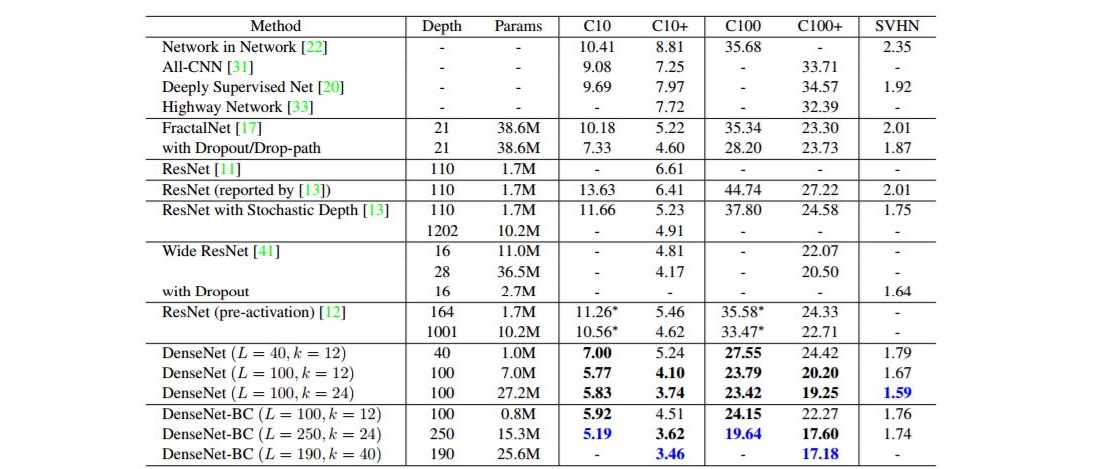DenseNet implements of PyTorch.
Project description
DenseNet-PyTorch
Now supports the more efficient DenseNet-BC (DenseNet-Bottleneck-Compressed) networks. Using the DenseNet-BC-190-40 model, it obtaines state of the art performance on CIFAR-10 and CIFAR-100.
Update (January 15, 2020)
This update allows you to use NVIDIA's Apex tool for accelerated training. By default choice hybrid training precision + dynamic loss amplified version, if you need to learn more and details about apex tools, please visit https://github.com/NVIDIA/apex.
Update (January 6, 2020)
This update adds a modular neural network, making it more flexible in use. It can be deployed to many common dataset classification tasks. Of course, it can also be used in your products.
Overview
This repository contains an op-for-op PyTorch reimplementation of Densely Connected Convolutional Networks.
The goal of this implementation is to be simple, highly extensible, and easy to integrate into your own projects. This implementation is a work in progress -- new features are currently being implemented.
At the moment, you can easily:
- Load pretrained DenseNet models
- Use DenseNet models for classification or feature extraction
Upcoming features: In the next few days, you will be able to:
- Quickly finetune an DenseNet on your own dataset
- Export DenseNet models for production
Table of contents
About DenseNet
If you're new to DenseNets, here is an explanation straight from the official PyTorch implementation:
Recent work has shown that convolutional networks can be substantially deeper, more accurate, and efficient to train if they contain shorter connections between layers close to the input and those close to the output. In this paper, we embrace this observation and introduce the Dense Convolutional Network (DenseNet), which connects each layer to every other layer in a feed-forward fashion. Whereas traditional convolutional networks with L layers have L connections - one between each layer and its subsequent layer - our network has L(L+1)/2 direct connections. For each layer, the feature-maps of all preceding layers are used as inputs, and its own feature-maps are used as inputs into all subsequent layers. DenseNets have several compelling advantages: they alleviate the vanishing-gradient problem, strengthen feature propagation, encourage feature reuse, and substantially reduce the number of parameters. We evaluate our proposed architecture on four highly competitive object recognition benchmark tasks (CIFAR-10, CIFAR-100, SVHN, and ImageNet). DenseNets obtain significant improvements over the state-of-the-art on most of them, whilst requiring less memory and computation to achieve high performance.
Installation
Install from pypi:
pip install densenet_pytorch
Install from source:
git clone https://github.com/Lornatang/DenseNet-PyTorch
cd DenseNet-PyTorch
pip install -e .
Usage
Loading pretrained models
Load an densenet121 network:
from densenet_pytorch import DenseNet
model = DenseNet.from_name("densenet121")
Load a pretrained densenet11:
from densenet_pytorch import DenseNet
model = DenseNet.from_pretrained("densenet121")
Details about the models are below:
Example: Classification
We assume that in your current directory, there is a img.jpg file and a labels_map.txt file (ImageNet class names). These are both included in examples/simple.
import json
from PIL import Image
import torch
from torchvision import transforms
from densenet_pytorch import DenseNet
model = DenseNet.from_pretrained("densenet121")
# Preprocess image
tfms = transforms.Compose([transforms.Resize(224), transforms.ToTensor(),
transforms.Normalize([0.485, 0.456, 0.406], [0.229, 0.224, 0.225]),])
img = tfms(Image.open('img.jpg')).unsqueeze(0)
print(img.shape) # torch.Size([1, 3, 224, 224])
# Load ImageNet class names
labels_map = json.load(open('labels_map.txt'))
labels_map = [labels_map[str(i)] for i in range(1000)]
# Classify
model.eval()
with torch.no_grad():
outputs = model(img)
# Print predictions
print('-----')
for idx in torch.topk(outputs, k=5).indices.squeeze(0).tolist():
prob = torch.softmax(outputs, dim=1)[0, idx].item()
print('{label:<75} ({p:.2f}%)'.format(label=labels_map[idx], p=prob*100))
ImageNet
See examples/imagenet for details about evaluating on ImageNet.
Contributing
If you find a bug, create a GitHub issue, or even better, submit a pull request. Similarly, if you have questions, simply post them as GitHub issues.
I look forward to seeing what the community does with these models!
Project details
Download files
Download the file for your platform. If you're not sure which to choose, learn more about installing packages.
Source Distribution
Built Distribution
Hashes for densenet_pytorch-0.1.0-py2.py3-none-any.whl
| Algorithm | Hash digest | |
|---|---|---|
| SHA256 | c735129e3eb4c17ac21abc8fbfcd52f31dbf4db26cc692ca09affcf2a6bbe198 |
|
| MD5 | 3f4ad7ff63cedd500bb3ad6815fea8d3 |
|
| BLAKE2b-256 | fc01be33f8d6838b6d659d4cdc28a85bf918abbff6cacfb2256b5ec79d1cb4bb |












